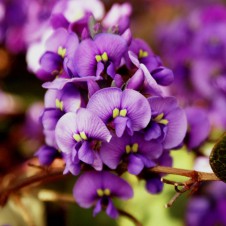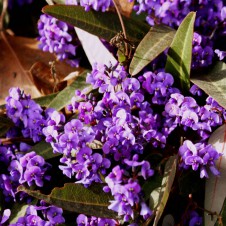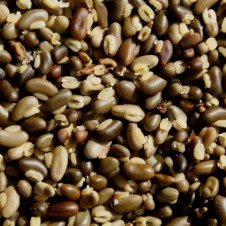General Description: A vigorous, scrambling and twining plant with branchlets to several metres long and large, glossy-green, prominently net-veined, leaves. Flowers consist of masses of deep purple, pea flowers. This indigenous variety does not climb upwards as much as some cultivars, such as ‘Happy Wanderer’ but does an amazing job as a ground cover and will grow quite high if it finds something to climb.
Flowers and Fruit: Flowers are purple with yellow-green central streak near base and flowering occurs from July to November. Fruit is an linear pod containing 3-8 kidney-shaped, brown seeds, to 5mm long.
Site Preference and Tolerances: A very hardy plant that will adapt to a range of soil types but prefers clay soils. Prefers full sun but will tolerate shade. Requires well drained soils and will withstand periods of drought.
Life Span: Medium (20 to 80 years).
Wildlife Value: Provides good cover for many ground dwelling creatures and a food source for seed eating insects, animals and birds.
Other Values and Uses: This is the local form of this showy wiry creeper with beautiful purple pea flowers and dark green leaves and it scrambles over the ground making a great ground cover. Its purple flowers can be used as a source of dye. It can be grown in hanging baskets and containers and is useful for covering embankments. Its role in the bush ecology can be considered similar to that of legume shrubs.
Other Scientific Names: Glycine violacea, Hardenbergia monophylla, Kennedia monophylla
Other Common Names: False Sarsparilla, Native Lilac, Sarsaparilla
Germination Information: Need to break seed dormancy and heat treatment using hot water is best for this species, do not use just boiled water. Pour hot water (can just put your finger in it briefly) over the seed and leave it for at least half an hour to ensure the seedcoat is cracked and the seed has taken in some water.



